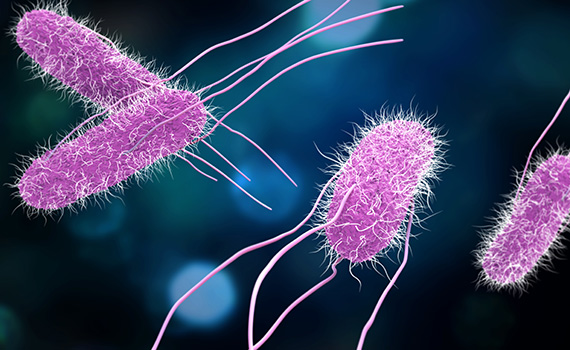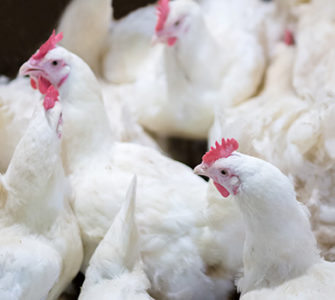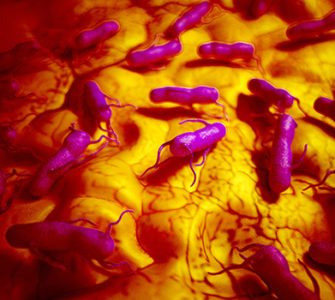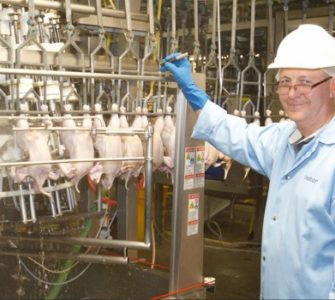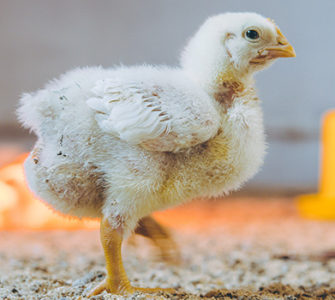Modified-live vaccination reduced salmonellosis in Brazilian study
New research confirms that modified-live vaccines (MLVs) can effectively reduce salmonellosis in broilers — a leading cause of food poisoning in humans and one of the most critical food-borne diseases affecting international trade in poultry.1
The research was conducted to test the ability of a commercially available MLV to cross-protect against a field strain of S. Heidelberg (SH) that is prevalent on Brazilian broiler farms and widely implicated in non-typhoidal Salmonella infections.2
According to Eduardo Muniz, one of the study’s investigators and a poultry veterinarian at Zoetis, Salmonella bacteria are ubiquitous in the poultry environment and nothing new in broiler production. But as the world’s largest exporter of poultry meat, Brazil has made Salmonella control an urgent priority in recent years as the EU and other markets have adopted stricter standards to safeguard public health and more rigorous testing for imported products.
To tackle the issue, the broiler sector in Brazil is taking steps to improve Salmonella control throughout the supply chain. In production, killed and attenuated, live Salmonella vaccines have been used for decades in breeders to control vertical disease transmission, Muniz explains. However, MLVs — live vaccines that have been genetically modified to prevent the vaccine strain from becoming virulent — have gained considerable attention due to their significant and well-documented advantages, including greater cross-protection and safety.4
“The epidemiology and control of Salmonella are notoriously complex, as they depend on many factors including serotype, host, environment and geographic features. MLVs can help mitigate these factors by stimulating active immunity to a wider range of Salmonella strains,” he says.
“Consistent with previous findings, the MLV we tested in this Brazilian study significantly reduced SH counts in challenged birds when administered in two applications, indicating that it is a safe and effective option for controlling salmonellosis in broilers.”
Study design
Published in Avian Pathology,3 the study evaluated a commercially available vaccine based on S. typhimurium (ST), which produces antigens in a similar configuration to SH and has previously been shown to provide good cross-protection against various SH serovars. The research was conducted by Zoetis in collaboration with Brazil’s Federal University of Rio Grande do Sul and the Mercolab laboratory.
For the study, 80 broiler chicks were divided in 4 groups (T1, T2, T3 and T4) of 20 birds each. Two groups (T1 and T2) were challenged with a common Brazilian field strain of SH on day 3, and the other two groups (T3 and T4) were challenged on day 21. Half the birds (T1 and T3) were vaccinated according to label instructions, with one application by spray in the hatchery on day 1 and the second via drinking water on day 14. The other half (T2 and T4) were not vaccinated and served as positive control.
At the end of the study, researchers evaluated ceca, liver and spleen samples for quantitative and qualitative SH analysis. The liver and spleen samples showed that vaccination significantly (P ≤ 0.05) reduced the percentage of SH positivity in the group challenged at 3 days of age, while in the group challenged at 21 days this difference was almost considered significant (P = 0.1818). There was no statistically significant difference in SH count in the caecum (CFU/g) in the group challenged at 3 days, but for the group challenged at 21 days, the SH counts were significantly (P ≤ 0.05) lower in the vaccinated group when compared to the positive control.
Significantly reduced SH counts
Based on these results, researchers concluded that the best protection was achieved in group T3, which was vaccinated in two doses and challenged on day 21.
“These results confirm that the ST vaccine was able to significantly reduce bacterial SH burden in the cecum, liver and spleen after oral challenge with a Brazilian field strain. This reinforces the vaccine’s efficacy in the control of salmonellosis caused by SH in broilers, particularly when the challenge is encountered later in the bird’s life,” Muniz says.
“It should be emphasized that the efficacy of cross-protection for SH depends on at least two vaccine applications,” he adds. “This means that birds should be immunized as soon as possible during the first days of life so that they have time to develop immunity and receive the second dose.
MLVs are not a ‘magic bullet’, Muniz stresses, and steps need to be taken to control Salmonella at all stages of the supply chain, from production and processing to packaging and transport.
“As part of a holistic Salmonella management strategy, however, MLVs are valuable tools for reducing salmonellosis in broilers, thus improving the safety and quality of poultry products,” he concludes.
To access the published study, click here.
1 Muniz et al. “Evaluation of the effectiveness and safety of a genetically modified live vaccine in broilers challenged with Salmonella Heidelberg.” Avian Pathology, volume 6, issue 6, 2017.
2 Ibid
3 ibid
4 Alderton et al. “Humoral responses and Salmonellosis protection in chickens given a vitamin-Dependent Salmonella Typhimurium Mutant”. Avian Diseases, volume 35, issue 3, pp. 435-442, 1991.
Posted on September 20, 2018



